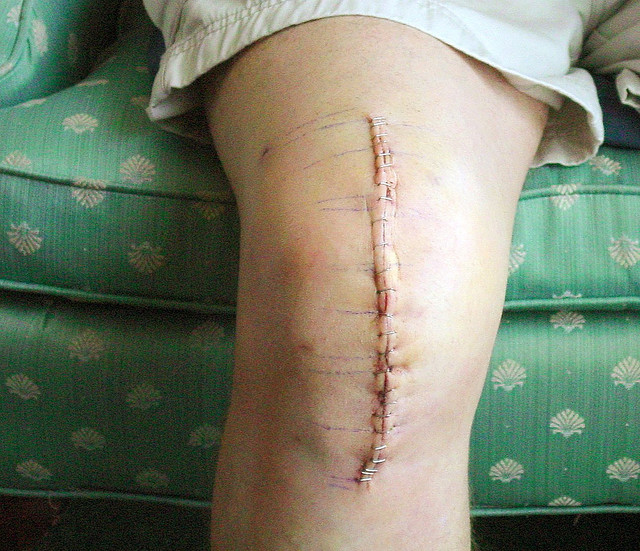As an orthopedic surgeon, I spend a majority of my time dealing with knees—with everyone from teenagers to 90-year-olds, from professional athletes to weekend warriors and to people who just want to walk in comfort.
For many of us, pain and knees go together—34 percent of Americans over the age of 54 said they suffer from chronic knee or leg pain—and seven million Americans (about 1.5 percent) have had a knee replacement. But as a surgeon, I actually try my best to help my patients avoid surgery.
As I tell my patients, if you’re willing to make some basic lifestyle changes and stick to them, you may be able to keep your knees happy and relatively painless—not only postponing knee surgery but perhaps not needing surgery at all.
These are not complicated methods–they’re designed with my patients in mind.
Here are five key steps for healthy, happy knees:
1. Make friends with your knees.
In other words, get to know your knees. They’re not just a bump between shin and thigh, they’re also one of the largest, most complicated joints in our body. They are a combination of sturdy construction and tricky mechanics, and a lot can go wrong—and does. But whether it’s knee pain due to arthritis, ligament tears, cysts in the back of the knee, pain behind the kneecap or trauma—what is most important is what you do to treat your pain. And don’t ignore it, either—treat the knee as a friend in a relationship that needs to be maintained.
2. Eat and drink with your knees in mind.
That means drink water and loads of it—water is essential for knee health. Knees contain cartilage, a soft spongy tissue that lines the ends of our joints, enabling us to move pain-free. Cartilage is comprised mostly of water—up to 80 percent when we’re properly hydrated. But the older we get, the lower the water content gets (to as low as 70 percent), which can cause cartilage to become unhealthy. That, in turn, will hasten the progress (and pain) of degenerative joint disease. So, drink a glass before and after each meal. Drinking water also helps control your appetite, which is vital—you want to lighten the load your knees endure. For each pound your body carries, your knees endure four pounds of pressure every step, and the pressure increases with the level of activity. One easy way—simply cut your portions in half.
3. Supplement your diet with glucosamine sulfate and turmeric.
Yes, I’m a medical doctor recommending two natural supplements—not the norm, to be sure—but they work. And more and more doctors like myself believe that supplements are well worth the try and are generally safer than many other treatments. According to the National Institutes of Health, glucosamine sulfate is “likely effective” for treating osteoarthritis. And the more we learn about turmeric, the more I like it—used medicinally for thousands of years, turmeric was found to ease pain as well as ibuprofen by recent research.
4. Start moving, even baby steps.
The mechanics of the knee require movement for health. Unlike most other tissues in the body, cartilage lacks blood vessels to carry nutrients into it, so movement is what pushes that vital material its way. Even if it’s just walking down the hall—get up and go. Pick an activity you enjoy and ramp up. The goal is five days a week, 30 minutes a day. It doesn’t have a 30 minute chunk, either—you can do 10 minutes here, 10 minutes there. And moderate exercise is fine. To stay motivated, reach out to a buddy, play music, or set yourself up with a great podcast. Turn movement into a habit, not a special occasion.
5. Focus on the knees with dedicated exercises.
The same way athletes combine workouts with warm-ups for strength training, you should combine your new habit of moderate to strenuous movement with exercises designed specifically for your knees. I worked with a physical therapist on a simple, 10-minute program—no gym required—that includes balancing and strengthening exercises. Many can be done using just a chair, and they include heel raises, marching in place, hip abductions and extensions, hamstring curls, quad lifts and lunges. And remember—if what you’re doing isn’t aggravating your condition, it’s helping it.
The truth is, nearly everyone’s knees will give them trouble eventually. At some point, knees just degenerate. But it doesn’t have to be the end of your ability to move, and it may not happen at all. The more you know about your knee, the better you can discuss next steps with your doctor, as well. And by embarking on these five steps—if you do need surgery, you’ll be in far better shape on the other side.
.
Relephant:
Inner Knee Pain.
Relephant bonus (an exercise to help you stay healthy):
.
Author: Gregory M. Martin, M.D.
Editor: Yoli Ramazzina
Photo: Flickr/sophie & cie; Flickr/F Delventhal







Read 1 comment and reply